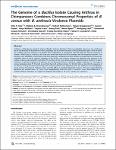The Genome of a Bacillus Isolate Causing Anthrax in Chimpanzees Combines Chromosomal Properties of B. cereus with B. anthracis Virulence Plasmids
Klee, Silke
Brzuszkiewicz, Elzbieta B.
Nattermann, Herbert
Brüggemann, Holger
Dupke, Susann
Wollherr, Antje
Franz, Tatjana
Pauli, Georg
Appel, Bernd
Liebl, Wolfgang
Couacy-Hymann, Emmanuel
Boesch, Christophe
Meyer, Frauke-Dorothee
Leendertz, Fabian
Ellerbrok, Heinz
Gottschalk, Gerhard
Grunow, Roland
Liesegang, Heiko
Anthrax is a fatal disease caused by strains of Bacillus anthracis. Members of this monophyletic species are non motile and are all characterized by the presence of four prophages and a nonsense mutation in the plcR regulator gene. Here we report the complete genome sequence of a Bacillus strain isolated from a chimpanzee that had died with clinical symptoms of anthrax. Unlike classic B. anthracis, this strain was motile and lacked the four prohages and the nonsense mutation. Four replicons were identified, a chromosome and three plasmids. Comparative genome analysis revealed that the chromosome resembles those of non-B. anthracis members of the Bacillus cereus group, whereas two plasmids were identical to the anthrax virulence plasmids pXO1 and pXO2. The function of the newly discovered third plasmid with a length of 14 kbp is unknown. A detailed comparison of genomic loci encoding key features confirmed a higher similarity to B. thuringiensis serovar konkukian strain 97-27 and B. cereus E33L than to B. anthracis strains. For the first time we describe the sequence of an anthrax causing bacterium possessing both anthrax plasmids that apparently does not belong to the monophyletic group of all so far known B. anthracis strains and that differs in important diagnostic features. The data suggest that this bacterium has evolved from a B. cereus strain independently from the classic B. anthracis strains and established a B. anthracis lifestyle. Therefore we suggest to designate this isolate as ‘‘B. cereus variety (var.) anthracis’’.
Dateien zu dieser Publikation
Keine Lizenzangabe
Verwandte Publikationen
Anzeige der Publikationen mit ähnlichem Titel, Autor, Urheber und Thema.
-
2007-05-25ZeitschriftenartikelFepA- and TonB-dependent bacteriophage H8: receptor binding and genomic sequence. Rabsch, Wolfgang; Ma, Li; Wiley, Graham; Najar, Fares Z.; Kaserer, Wallace; Schuerch, Daniel W.; Klebba, Joseph E.; Roe, Bruce A.; Gomez, Jenny A. Laverde; Schallmey, Marcus; Newton, Salete M. C.; Klebba, Phillip E.H8 is derived from a collection of Salmonella enterica serotype Enteritidis bacteriophage. Its morphology and genomic structure closely resemble those of bacteriophage T5 in the family Siphoviridae. H8 infected S. enterica ...
-
2005-06-20ZeitschriftenartikelViral promoters can initiate expression of toxin genes introduced into Escherichia coli Lewin, Astrid; Mayer, Martin; Chusainow, Janet; Jacob, Daniela; Appel, BerndBackground: The expression of recombinant proteins in eukaryotic cells requires the fusion of the coding region to a promoter functional in the eukaryotic cell line. Viral promoters are very often used for this purpose. ...
-
2013-08-08ZeitschriftenartikelCytomegalovirus Downregulates IRE1 to Repress the Unfolded Protein Response Stahl, Sebastian; Burkhart, Julia M.; Hinte, Florian; Tirosh, Boaz; Mohr, Hermine; Zahedi, René P.; Sickmann, Albert; Ruzsics, Zsolt; Budt, Matthias; Brune, WolframDuring viral infection, a massive demand for viral glycoproteins can overwhelm the capacity of the protein folding and quality control machinery, leading to an accumulation of unfolded proteins in the endoplasmic reticulum ...

